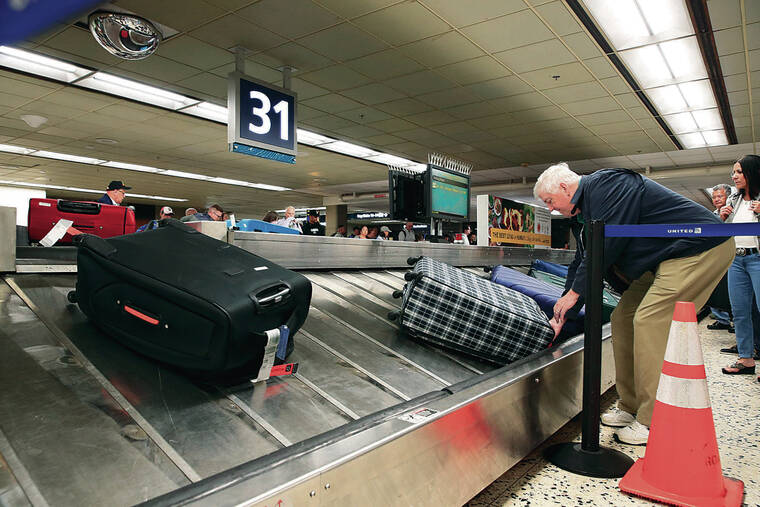Rosy U.S. summer travel forecast excludes Hawaii
U.S. Transportation Security Administration officials say they are preparing for the highest passenger volumes ever seen at airport security checkpoints nationwide during the peak summer travel season, which begins Memorial Day weekend and runs through Labor Day.
The sunny summer travel forecast is not shared with Hawaii’s tourism industry.
ADVERTISING
On Thursday, TSA officials forecast that over 3 million passengers and crew members will come through airport security checkpoints on May 24, the biggest travel day of the Memorial Day weekend. Through May 29, TSA expects to screen 18 million passengers and crew, a 6.4% increase compared with the same period in 2023.
That’s the opposite of what’s happening in the islands, where booking data and air seat projections point to a slowdown.
Travel deals to Hawaii abound, with some hotels offering a fourth or fifth night free, resort spending credits, discounts on meals or attractions, and steeper discounts for kamaaina, including resort fee waivers.
Jack Richards, president and CEO of Pleasant Holidays, said summer bookings to Hawaii are still down 28% from 2023. In comparison, he said bookings to Mexico in the same period have increased 5% and are up double digits for Western Europe and triple digits to Asia.
Keith Vieira, principal of KV &Associates, Hospitality Consulting, estimates that hotel bookings to Hawaii for summer are down about 10% to 12% compared with last summer.
Jerry Gibson, president of the Hawaii Hotel Alliance, said, “I wish TSA was right — statewide we aren’t having a good summer. We don’t see anything in advance bookings that is telling us that it’s going to be robust whatsoever. In fact, we are seeing a negative booking pace for June through the rest of the year. All the hotels that I know are buckling down and looking at doing specials.”
Toni Marie Davis, executive director at the Activities &Attraction Association of Hawaii, said, “Summer looks like a shoulder season.”
Chris Kam, president and chief operating officer of Omnitrak, said the firm’s research into the penetration rate of U.S. travelers supports TSA’s expectations for a summer rush; however, he said Hawaii is not performing at that level.
Kam said the rate of U.S. visitors who took a trip in March divided by the number who could have taken a trip was slightly above the March 2019 penetration rate.
“This measure is for the U.S. as a whole, and it was the first time that we’ve seen the penetration rate go above the 2019 level,” Kam said. “We’re not there yet in Hawaii.”
He said Hawaii is challenged by a decline in scheduled nonstop domestic air seats, which was flat heading into summer. From May to July, domestic seats were up 0.3% from the same period in 2023; however, there was zero growth for Hawaii’s core U.S. West market, according to data from the state Department of Business, Economic Development and Tourism.
While nonstop domestic air seats to Oahu and Kauai increased, the gain was not enough to offset the single- digit decline for Kona and the double-digit decline for Maui.
“It would be hard to grow the U.S. market in a market where there is no growth in air seats. You still can’t drive to Hawaii,” Kam said. “At best they are looking at a flat summer, I guess, but then there are the demand issues.”
He said fewer air seats often means that travelers will find that booking travel is less convenient and more expensive. Kam added that the allure of international travel also has been affecting demand from Hawaii’s core domestic market since 2023.
“A lot of travelers that would have gone overseas to Hawaii are now going to the Caribbean, Mexico and Western Europe and Asia,” Kam said.
Davis said social media is exacerbating the situation by introducing visitors to “‘travel dupes,’ which is short for duplicates. They are looking for places that deliver what Hawaii does but without the guilt that they are thinking they are intruding on us, without the potential overcrowding, but probably the biggest thing is without the expense. Hawaii is one of the most expensive vacations that a person can take from the U.S. I’ve heard that the Azores is a ‘travel dupe’ for Hawaii.”
Richards said given that the booking window for Hawaii has shortened, it’s possible that the booking gap could narrow.
“If it’s going to happen, we’ll see a bump right after Memorial Day,” he said. “We are trying to increase demand. On Thursday we launched a free-nights-in-Hawaii vacation sale offering a fourth, fifth and even sixth night free for travel at 21 hotel and resorts on four islands.”
But Richards added that he expects much of the softness to persist, led by continued challenges of the Aug. 8 wildfires on Maui. Right after the wildfires, tourism to all of Maui was shut down. Tourism to areas outside of West Maui reopened shortly after, but it was Nov. 1 before government officials allowed tourism to West Maui outside of Lahaina to reopen.
These regulations, combined with strong social media messaging, especially from celebrities, that Maui should stay closed to give wildfire survivors time to grieve and heal, resulted in immediate and large economic losses. Hawaii’s visitor industry has been working on the reopening messaging ever since, but there are still reports that visitors to Maui or even other islands, untouched by the wildfires, worry that they won’t be welcome.
Richards said visitor demand for Maui should improve since advocacy group Lahaina Strong quit occupying Kaanapali Beach.


